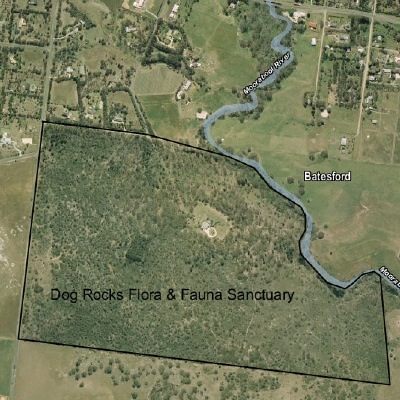About Dog Rocks Flora & Fauna Sanctuary
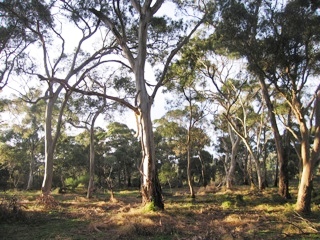
Gum trees in afternoon light
The Dog Rocks Flora and Fauna Sanctuary, near Geelong, was established when the previous owner George Belcher’s great grandfather purchased the property in 1856. The Belcher Family has preserved the Sanctuary as valuable and beautiful natural bush land for over a century, and it has become an important area of conservation for our rapidly disappearing flora and fauna.
The Sanctuary is situated adjacent to the Dog Rocks outcrop on the top of a hill in west Batesford, west of Geelong, in Victoria. The Dog Rocks themselves, as well as the rocks in the Sanctuary, are an outcrop of Devonian granite (similar to the You Yangs), intruded some 350 million years ago, the highest point now being just over 100 metres above sea level. Imagine some 15 million years ago, (when the underlying Batesford limestone was being formed), a warm sea extending over and beyond the area with the Dog Rocks forming an island. The nearby limestone quarry has subsequently revealed many sea fossils.
The Dog Rocks Flora and Fauna Sanctuary is an area of 83 hectares with a frontage to the Moorabool River. George and Lit Belcher have generously leased a strip of land beside the river to the City of Greater Geelong for the development of a public footpath. In addition they recently negotiated a covenant with Trust for Nature to ensure that the Dog Rocks Flora and Fauna Sanctuary, best described as a large and complex ecology of flora and fauna in open eucalyptus woodland, remains as it is for future generations. The Dog Rocks are also managed and protected by a Trust for Nature Covenant. Trust for Nature, is an independent not-for-profit organisation which protects, manages and conserves biodiversity for future generations.
The Flora and Fauna
Beneath the ground to the tops of the tallest trees this open eucalyptus woodland nurtures a rich variety of flora and fauna. Here the remains of rare local native vegetation can be found. Plants such as the Chocolate Lily, the Rock Correa and the Yellow Gum, as well as introduced non-local native plants. It also contains vigorous and invasive weed species such as bone seed and blanket weed which if not contained will smother the native vegetation which supports the bird and animal life.
The Sanctuary is recognised for its concentration of bird life and provides a protected haven and habitat for them. Recorded sightings include a variety of resident, occasional, migrant and rare species. Birds such as the Tawny Frogmouth, the Sacred Kingfisher and the Nankeen Kestrel have been sighted regularly in the Sanctuary. Unlike city dwellers, Batesford residents in the nearby rural-residential settlement adjacent to the Sanctuary, are blessed with an abundance of bird life in their backyards. In the past the Geelong Field Naturalists Club has extensively documented the flora and fauna in the Dog Rocks Flora and Fauna Sanctuary. This is currently being updated.
The Sanctuary also contains a variety of mammals and reptiles of both the cute and scary variety, which are all part of the complex ecology of the area and make it so valuable. These include echidnas, and small families of koalas and kangaroos, as well as lizards such as the Tree Dragon and the Blue -Tongue, and a number of snakes including the Tiger and Brown. The Sanctuary provides a nurturing habitat for flora and fauna and protects them from predators outside its borders, not least of which is sometimes the domestic dog and cats both domestic and feral.
The future of our native flora and fauna is dependent on what we do in the cities and on farms, as well as on the few remaining areas of land such as the Sanctuary, where the remains of our native flora and fauna survive and retain the complex biodiversity that is so important for our survival as a planet.
Working with Schools and other Organizations
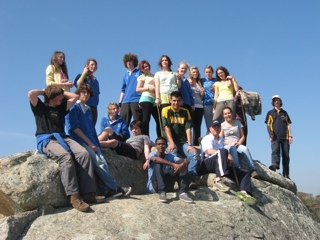
Covenant College students on the Dog Rocks outcrop
Currently, with the assistance of St Joseph’s College, Covenent College and the Medibank Private managers community service Better Health Program, we are removing invasive weeds in the Sanctuary to enable the regeneration and re-establishment of flora which naturally occurred in this grassy woodland. Some of the flora may not regenerate in desirable numbers or densities so subsequently we will plant grass species which already exist in the Sanctuary. Re-introducing the original plant species that grew in the Sanctuary provides a much greater and healthier habitat for native animals, birds, reptiles and insects.
Since 2006 St Joseph’s College and Covenant College have been actively involved with the Sanctuary through their Community Service programs. They have been involved in weed and fuel reduction and indigenous plant regeneration. They each have their own areas in which to work, identified by signs with their school crests.
Covenant College Year 9 students and teachers John Rees and Stephen Demetriou have been supporting the work of the Belcher family and BFS Landcare group in the Sanctuary since 2010. The reduction and eradication of an area densely covered in mature boneseed, a weed of national significance, was the task allocated for the school. The result is amazing. Grasses and shrubs of local provenance propagated by the students at Barwon Water nursery have now replaced boneseed. Acacia identification, Water Watch and fitness activities have also been included in the students’ program in DRFFS.
We look forward to a continuing partnership with Covenant College, St Joseph’s College and other interested schools in the future and greatly appreciate their support.
Working Bees
Working bees are held throughout the year. If you would like to help or want more information, please click the button below to send us an email.
It goes without saying that all our lives are increasingly busy and committed. We understand this. But perhaps you could spare one or two half days a year to help out? We are seeking your assistance in whichever way you, your family or friends may be able to participate.
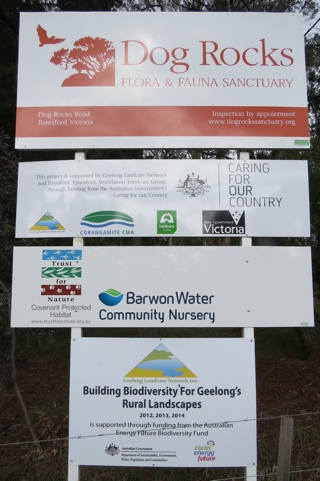
Current Projects
Communities for Nature 2013 Small Grant ($20,000)
Victorian Government — Dept. of Environment and Primary Industry
A two year grant for the Restoration of the Dog Rocks Flora and Fauna Sanctuary.
This involves the control of pest animals such as rabbits and foxes and the control of weeds including Bridal Creeper, Serrated Tussock, Boneseed and Blanket Weed. It also enables BFS Landcare group to organise community events, prepare and distribute advertising material and train volunteers including St Joseph's College, Covenant College and Medibank (For Better Health Program) with support from the City of Greater Geelong.
Biodiversity Fund ($15,000)
Australian Government — Dept. Sustainability, Environment, Water, Population and Communities.
‘Building Biodiversity across Geelong’s Rural landscape’ — Geelong Landcare Network.
This involves remnant vegetation protection, the removal of pine trees and a local collaborative rabbit control program with a co-ordinated approach across public and private land including small landholders with the Golden Plains Shire and the City of Greater Geelong. It also enables the regeneration of indigenous vegetation including the creation of a Callitris nursery surrounded by rabbit proof fencing which includes the source of the seedlings, an ancient Callitris gracillis tree.
Custodians and Managers of the Sanctuary
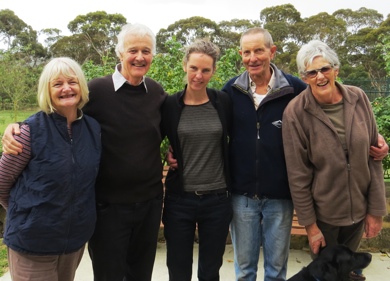
Above L to R:
Batesford-Fyansford-Stonehaven Land Care Business Manager Helen Percy, BFS President Peter Spear, current Geelong Landcare Network Coordinator Elissa Ashton Smith, previous Sanctuary Custodians George and Lit Belcher,and Syd the dog.
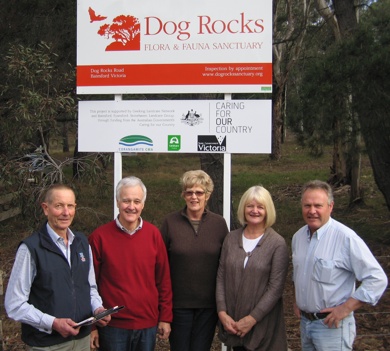
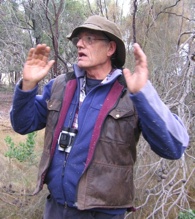
Above L to R:
George Belcher previous Custodian DRFFS, Peter Spear President BFSLC, Lit Belcher previous Custodian DRFFS, Helen Percy Secretary BFSLC, Bronte Payne previous Landcare Coordinator, Geelong Landcare Network.
Left: Ted Thornley, (brother of Lit Belcher) knowledgable and passionate worker for the Sanctuary.

